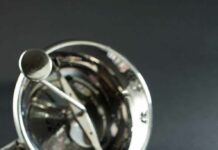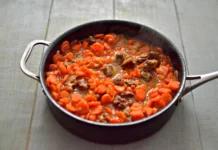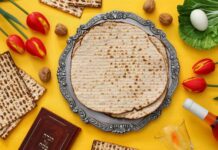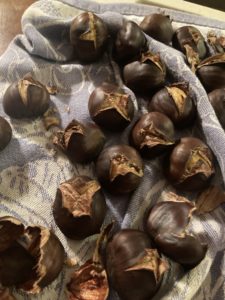
When traveling in Rome last year with my daughter, I bought a cup of roasted chestnuts from a street vendor. They were utterly intoxicating, and we have both been sort of obsessed ever since.
We managed to find Italian chestnuts for sale at Iovine Produce in Reading Terminal Market and attempted to recreate our Roman snack. We know that everything tastes better in Italy, and the bustle at the bottom of the Spanish Steps enhanced the culinary experience, but, objectively, our version was a pretty good substitute.
Before we get to the recipes, however, let’s look at the nutritional punch chestnuts pack. Low in fat and high in fiber and vitamin C, chestnuts deliver a healthy dose of antioxidants, magnesium and potassium. They can be served on their own as a snack, ground into a flour and can swing to both savory (pasta or stuffing anyone?) and sweet dishes (see below) to great effect.
Roasted Chestnuts
The key, we learned, is to boil the chestnuts first. A food scientist can probably explain the thermodynamics of the technique; I’ll just say that one long-ago winter, my husband and I had the “romantic” notion of roasting chestnuts on an open fire. Many cut fingers, a few splinters and zero delicious snacks later, we abandoned the effort and never tried again.
But my daughter was determined; she researched it and found the secret. Here’s what we did:
1 pound chestnuts in shells
Heat your oven to 425 degrees.
Make an “X” cut across the brown, rounded side of each chestnut. Be sure to penetrate both the shell and the inner skin.
Place the cut chestnuts in a pan of cold water. Bring it to a boil, and immediately drain the chestnuts.
Place the boiled chestnuts cut side up on a baking tray, and roast them in the oven for about 20 minutes. Remove the chestnuts from the oven, wrap them in a clean kitchen towel and allow them to sit for about 10 minutes.
Enjoy the chestnuts as soon as they have cooled slightly in the towel. Be sure to peel any leftovers before they cool (or they are difficult to remove from the shell), and store them in the refrigerator for a few days or freeze them for a few months.
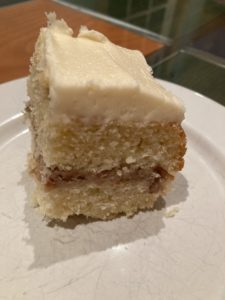
Chestnut-filled Cake
Makes 1 square cake
This is a “go-to” cake recipe for me — dense, buttery, vanilla and fairly foolproof. It married beautifully with the chestnut filling, but I’ve made it dozens of times without the chestnuts, and it’s always a hit.
The cake:
2 cups plus 2 tablespoons cake flour
1 teaspoon baking powder
¾ teaspoon baking soda
½ teaspoon salt
1 stick unsalted butter, softened
1 cup sugar
1 teaspoon vanilla extract
2 eggs
1 cup buttermilk
Heat your oven to 350 degrees F.
Spray a square pan with oil, then line it with parchment paper; spray the parchment. Set it aside.
Sift the cake flour with the baking powder, soda and salt into a medium bowl; set it aside.
Beat the butter and sugar in a large bowl, and add the vanilla and eggs. Beat until blended. Slowly add the flour mixture and buttermilk, beating on low speed until just mixed.
Pour the batter into the pan, and bake 35 minutes, or until the edges are lightly brown, the center of the cake springs back when pressed and a toothpick comes out clean. Remove it from the oven, and let it cool completely before filling or icing.
The filling:
1½ cups roasted, shelled chestnuts
1½ cups milk
⅓ cup sugar
1 teaspoon vanilla
Mix all the ingredients in a medium saucepan, and heat them over medium-low. Allow it to simmer uncovered for about 20 minutes until the liquid is reduced to about ½ cup. Stir occasionally.
When done, remove it from the heat and, using an immersion blender, puree the mixture. (A regular blender also can be used; just use caution with the hot liquid.)
Buttercream icing:
½ stick butter, softened
2½ cups powdered sugar, or as needed for texture
1 teaspoon vanilla
1 tablespoon milk, or as needed for texture
Mix all the ingredients, blending until smooth. Adjust as needed with the milk and sugar to achieve spreading consistency.
Assemble the cake:
Slice the cooled cake horizontally across into two layers. Spread the chestnut filling on the bottom layer, and place the top cake layer over the filling. Top the cake with the buttercream icing.


